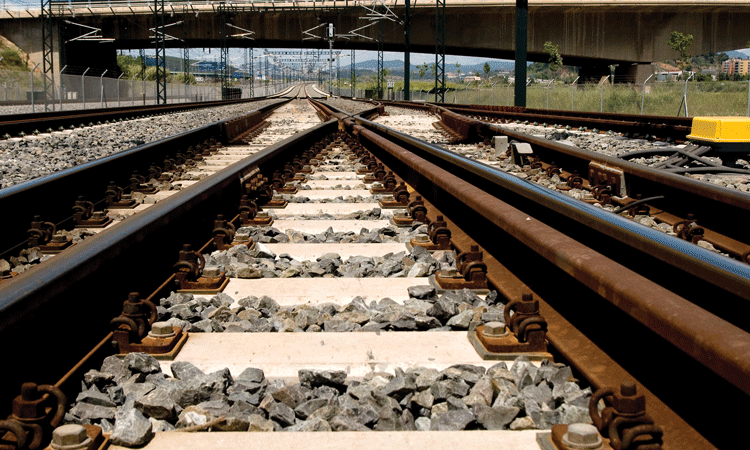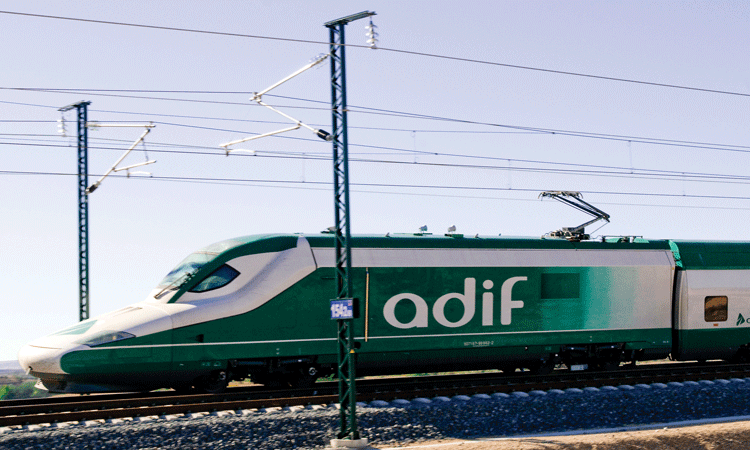Maintaining high-speed tracks on the Spanish network
Posted: 19 September 2014 | David-Iván Villalmanzo Resusta, Juan Antonio Villaronte Fernández-Villa | No comments yet
The first Spanish high-speed rail line from Madrid to Seville opened in 1992. Now, the Spanish high-speed rail network (operated by ADIF) includes 2,300km of double-track lines, 277km of bored tunnels and 326 hyperstatic and isostatic structures each spanning over 20m in length. Maintaining the track superstructure requires a lot of work. David-Iván Villalmanzo Resusta and Juan Antonio Villaronte Fernández-Villa from ADIF’s Maintenance and Operations Section of the High-Speed Network Deputy Direction, explain more.


Most modern tracks are formed by circular curves with radius of 7,300mm, with a distance between track axles of 4.70m, maximum gradients up to 25 mils, and ‘clothoid’ transition curves allowing maximum speeds up to 350km/h. However, current speeds operate at up to 300-310km/h.
Approximately 95% of the network consists of ballasted track with 60 E1 rail and pre-stressed monobloc concrete sleepers of type AI. Switches and crossings located on the main tracks have movable ‘nose’ crossings which allow passage by the straight track to the maximum speed, and up to 220km/h by the diverted track. The rest of the network consists of slab track of different technologies.
Maintenance is described by the UNE-EN 13306 as ‘the combination of all technical activities, administrative and management over the life-cycle of an element intended to keep it or return it to a state in which it can develop its required function’. We adopted this standard from the very start of operations of the very first line as an effective maintenance model.
However, with the progressive growth of the rail network and the opportunities to apply new technologies, maintenance is required to be in constant evolution, which must follow standards of reliability, comfort and security by ensuring the operation of the network, mainly oriented to passenger traffic, by any operator, both public and private. Recently, freight traffic on the approaches to the port of Barcelona have been passing from the international border with the French connection (Figueras-Perpignan operated by TP Ferro).
By applying an excellent and systematic procedure that controls the production processes, later developments of the model and its evolution have enabled the creation of a management model that has optimised the resources to develop this activity, so that the specific ‘actual’ costs of superstructure maintenance are approximately 25,000-30,000 Euros/km of double-track per yea – depending on the varying characteristics of its layout-design, infrastructure and track superstructure systems and orographic situation.
Maintenance planning
The maintenance activities provided by ADIF are being implemented as part of a deal agreed with the newly-created ADIF-High Speed (ADIF-Alta Velocidad) – the owner of the assets of the Spanish high-speed lines in standard gauge belonging to the REFIG (General Interest Railway Network; Red Ferroviaria de Interés General).
Maintenance planning of the track superstructure is conditioned by external factors which have a strong influence when making operational procedures, including:
- The high-speed network has an extensive and linear length
- Normally, maintenance operations have to be developed during ‘working windows’, implying track possessions that usually last five hours at night, including transfer time from the maintenance bases to the point of developing their tasks
- Highly-specialised operating tools are needed
- Control and safety operations in the development of work are complex, and must be regulated by: the CRCs, the specific traffic control management centers (Centros de Regulación y Control); the PMs (Puestos de Mando), for the control of the railway construction and maintenance assets; and CPS specific civil protection centers (Protection and Security Centres, Centros de Protección y Seguridad) for personnel and vehicle access to the track, as well as complementary services for the safety protection on the track during work.
Access to the track is a unique aspect in this maintenance plan because legally the sections of railway lines that operate at more than 160km/h are required to have full enclosure and vandal-resistant enclosures, structures of overpasses and noise barriers at specific points. Access doors are closed and only certain people have permission to enter those areas, having ordered the CPS express request for access to the fenced area, and obtaining the task manager/safety pilot when it is done.
The maintenance strategies try to combine the different possibilities and maintenance tools applied in the track superstructure, to achieve greater efficiency with greater availability and reliability of such infrastructures. For this purpose, the following three different maintenance methodologies are considered:
Cyclical maintenance
Through inspections, reviews and performances at established fixed intervals in time.
On-condition
Maintenance operations are carried out when certain limits, considered unacceptable, are exceeded. These limits are measured by specialised inspection vehicles.
Predictive
Experimentally taking advantage of technological advances in sensing and inspection, as well as studies of historical evolution, degradation, reliability and minimisation of risks and status applying techniques RCM (‘Reliability Centered Maintenance’).
To develop this maintenance plan, the high-speed lines have maintenance bases as work centers with an average distance between them of about 160km. These are equipped with specific track maintenance machines (tamping machine, ballast profiling machine, dynamic track stabiliser, self-propelled wagons) and specialised staff in different areas (revision and correction of track components, welders, machine operators, etc.). This territorial structure is supported by centralised departments equipped by specialist technical personnel and inspection vehicles.
Basic processes
Maintenance operations are strongly conditioned in the use of their potential resources. It is therefore necessary to implement this global vision in the overall planning and design of processes that take into account certain criteria of efficiency to establish the prioritisation of the task implementation. These can be divided into two main groups: 1) technical criteria; they require technology to optimise railway maintenance operations; and 2) economic criteria; they control the costs of the maintenance works to be performed.
Thereby, the technical and economic efficiency of the works are evaluated – not only to establish their priority, but if necessary, to recommend new investments.
It is for these reasons that the maintenance procedures, designed by ADIF, contemplate the whole life of the infrastructure from its initial design, during its operation when maintenance actions are applied, to the end of its life, when the decision of its possible renewal must be taken, regulated by a specific assets management plan (which follow the criteria established in the UNE-EN 55000).


Spain’s first high-speed line opened in 1992
The basic processes include the following:
Preventive maintenance
This defines the flow of cyclical activities scheduled to take on the railway superstructure, plus establishes the set of activities planned and scheduled according to the state of the element.
Corrective maintenance
This defines the repair of failures/defects in the superstructure involving the suspension of normal railway operations or restrictions on their usual terms of operation, and establishes the procedure for dealing with incidents (events/failures) of the superstructure that affect installation.
Improvement actions
This establishes a set of actions on the railway superstructure and capacity, through design improvements, technology enhancements or improvement performance, in order to increase its reliability and capacity. Also, process flow definition that the Project Management administrator must follow to achieve these improvements, as well as its overall design frame, environmental management, safety and health in its preparation or implementation.
For the purpose of this article, we are going to focus on the first two procedures as they constitute the total operating budget in ADIF for the conservation of the railway infrastructure. The last one comprises the investments in works funded by ADIF-High Speed (ADIF-Alta Velocidad).
Preventive maintenance
The process of preventive maintenance of the track superstructure consists of the following successive and cyclical stages:
- Inspection; knowledge of the current state of the superstructure through:
- Track geometry inspection; quarterly
- Dynamic inspection; monthly
- Ultrasonic inspection of the rail; annually
- Cabin-trip inspections; monthly
- Walk-inspection tours; biannual
- Specific inspections of switches and crossings; bimonthly on main line tracks, annual on parking tracks.
- Diagnostics and action planning
- Weekly schedule of maintenance works
- Execution of scheduled actions.
The following types of maintenance actions are carried out by external resources:
- Conservation of the quality of track geometry
- Conservation of the quality of the geometry and condition of switches and crossings
- Monitoring and ensuring the correct functioning of the elements of the track superstructure
- Implementation of immediate corrective actions after an incident
- Establishment of monitoring and preventive or corrective measures in case of an alert or other temporary causes
- Fire prevention.
These groups are usually broken down into the following actions:
- Alignment and longitudinal leveling: includes tamping, ballast profiling and track stabilisation
- Local geometric defects, as well as treatment and adjustment of track equipments (switches and crossings)
- Treatment of rail profile and rail grinding
- Review and/or partial replacement of elements (rails, sleepers, fastening systems), ballast cleaning (in short length)
- Regeneration and recovery tasks using recharge welding operations on switches and crossings
- Homogenisation and neutralisation of rail stresses
- Herbicide treatment.
In this process certain specific tools have been developed, such as an inventory data, maintenance service contracts divided into sections and applications that allow the registration, verifications and treatment of data from maintenance operations.
Corrective maintenance
The process of corrective maintenance of the track infrastructure and superstructure is aimed at the restoration of operation in sectors affected by faults affecting its functionality/operation. It consists of the following and successive stages:
- Detection, identification and opening of event/fault
- Success/failure analysis
- Final performance for the success/failure
- Overall assessment of performance
- Review and closing event/fault.
While maintenance is being carried out, communication, in terms of safety, established between the traffic control centers, the protection and safety centres and resources are crucial.
Quality of maintenance indicators
The overall scheme of evaluation of the effectiveness of maintenance is based on specific measurable parameters and quality thresholds defined by the following objective indicators:
Reliability
The Reliability index is defined as the percentage change in the number of faults in switches and crossings for reasons inherent to the Maintenance Contractor, between this year and the average of the previous two years.
Availability
The Reliability index in a given period is defined as the quotient expressed as a percentage, between the theoretical times for trains by the sum of the theoretical times plus the delays due to causes inherent of maintenance services.
Geometric Quality
As indicator of the geometric track quality control, in a given period, the results of track geometry parameters will be used (alignment and longitudinal leveling in various ranges of wave length) obtained by inspection vehicles.
Dynamic Quality
As an indicator of the dynamic track quality, in a given period, the number of overtopping (ZUT) thresholds established for monitoring parameters of accelerations in various parts of the inspection vehicles, going across the HSL at its maximum operating speed:
- Lateral in bogie
- Vertical in axle-boxes
- Lateral and vertical dynamic accelerations in vehicle box.
Conclusions
The accumulated experiences in the long period of HSL-High Speed Lines in service have allowed ADIF the following:
- Creating maintenance and work instructions, always in continuous improvement
- The generation of new forms contracts for maintenance services, with successive adaptations during the operation
- The progressive introduction of auxiliary tools and software-applications as support systems for maintenance management.
- The present approach of a progressive implementation of an Asset Management Plan allowing the lengthening of the life of the oldest existing infrastructure, planning early and rationally improved actions with LCC and RAMS objectives, and using these criteria for the strategic planning of new corridors or the improvement of capacity in the lines in service.












